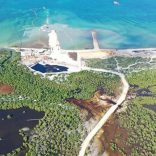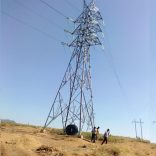EUMAM MOZ and FADM celebrate International Day of African Children at orphanage “Esperança”
Mozambique ranks second among countries with highest number of ecological threats

Mozambique faces the second highest exposure to ecological threats in the world, according to a classification released yesterday, which says the country may face five environmental threats by 2050.
According to the Ecological Threat Register, published by the Institute for Economics and Peace of Australia, Afghanistan, Mozambique and Namibia are the three countries among the 157 analysed with “highest exposure to ecological shocks”.
Afghanistan is expected to face six ecological threats and Mozambique and Namibia five by 2050, being classified as “high exposure” countries and with low levels of resilience.
Mozambique is also named as one of the “most fragile countries” most likely to collapse, along with Iran, Madagascar, Pakistan and Kenya.
“These countries are globally stable now, but have great exposure to ecological threats and low rates or deteriorating ‘Positive Peace’ (which measures resilience), which means that they are at greater risk of collapse in the future,” the report asserts.
Another 16 countries face at least four ecological threats.
🌍 The 19 countries facing the highest number of ecological threats are also among the world’s 40 least peaceful countries.
Investigate the data → https://t.co/LsL0h51dwD pic.twitter.com/EpSCbZD4qj
— Global Peace Index (@GlobPeaceIndex) September 11, 2020
Mozambique is also included among the 12 countries, all in Sub-Saharan Africa, with the highest prevalence of food insecurity, a list which also includes Angola. It is estimated that 65% of the Mozambican and Angolan populations, respectively 20.4 and 18 million people, faced in food insecurity in 2018.
Population growth in Sub-Saharan Africa, which is estimated at 2.4 million per year over the next three decades, is identified as one of the main threats in this region.
Although this estimate represents a decline in the average population growth that the region has seen in recent decades, “it is still beyond a sustainable level, given the increasing food and water shortages in the region”, according to the assessment.
At least 14 countries will double their population by 2050, including Portuguese-speaking Mozambique, which is expected to see its population grow from 31.26 to 65.31 million (+ 100%). Angola’s will rise from 32.87 to 77.42 million (+ 136%) and Equatorial Guinea’s from 1.4 to 2.82 million (+ 101%).
Mozambique has the seventh largest number of persons displaced by natural disasters, at 506,000 displaced.
“The impacts of rapid population growth are exacerbated by the high variability in climatic conditions, with more than half of the countries in the region (23 out of 43) suffering droughts,” the report details.
Angola is among the 32 countries with ‘medium exposure’ to ecological disasters, and faces three environmental threats, while Equatorial Guinea, Guinea-Bissau and Brazil are classified as low risk, with the possibility of facing only one ecological threat in the next 30 years.
The 2020 Ecological Threat Register (ETR) is now available for download.
The inaugural report analyses country risks from:
⭕ Population growth
⭕ Water stress
⭕ Food insecurity
⭕ Rising temperatures
⭕ Natural disasters
⭕ Sea levelsDownload now → https://t.co/IRRl4n3kqS pic.twitter.com/Fqo3pJiTqm
— Global Peace Index (@GlobPeaceIndex) September 9, 2020
A combination of environmental, social and economic issues poses a “major challenge” for food security in Sub-Saharan Africa, according to the document, which highlights conditions such as “rooted poverty, environmental degradation, rapid urbanisation, high rates of population growth and climate change”.
Sub-Saharan Africa has the highest prevalence of food insecurity, affecting 58% of the population overall. Most sub-Saharan African countries rely on rain for agriculture and food, making the region “particularly vulnerable” to climate change such as prolonged droughts and seasonal floods.
The Ecological Threat Register (ETR) identifies countries at greatest risk of ecological threat, focusing on the scarcity of resources and natural disasters and their impact on the lives of populations.
The ecological threats assessed by the index are water stress, food insecurity, droughts, floods, cyclones, rising temperatures, rising sea levels and population growth.
The register also analyses the impacts of ecological threats on countries’ tranquillity and levels of resilience in determining the capacity to adapt to and mitigate risks.
- You may read the Ecological Threat Register 2020 HERE.












Leave a Reply
Be the First to Comment!
You must be logged in to post a comment.
You must be logged in to post a comment.